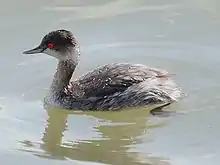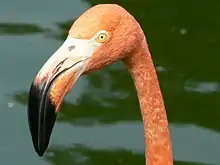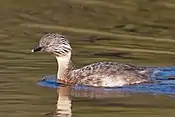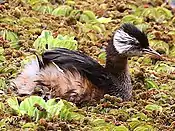Grebe
Grebes (/ˈɡriːbz/) are aquatic diving birds in the order Podicipediformes /ˌpɒdɪsɪˈpɛdɪfɔːrmiːz/.[1] Grebes are widely distributed freshwater birds, with some species also found in marine habitats during migration and winter. Some flightless species exist as well, most notably in stable lakes. The order contains a single family, the Podicipedidae, which includes 22 species in six extant genera. Although, superficially, they resemble other diving birds such as loons and coots, they are most closely related to flamingos, as supported by morphological, molecular and paleontological data. Many species are monogamous and are known for their courtship displays, with the pair performing synchronized dances across the water's surface. The birds build floating vegetative nests where they lay several eggs. About a third of the world's grebes are listed at various levels of conservation concerns—the biggest threats including habitat loss, the introduction of invasive predatory fish and human poaching. As such, three species have gone extinct.
| Grebes Temporal range: Oligocene-Holocene, | |
|---|---|
 | |
| Black-necked grebe (Podiceps nigricollis nigricollis), in non-breeding plumage | |
| Scientific classification | |
| Kingdom: | Animalia |
| Phylum: | Chordata |
| Class: | Aves |
| Clade: | Neoaves |
| Clade: | Mirandornithes |
| Order: | Podicipediformes Fürbringer, 1888 |
| Family: | Podicipedidae Bonaparte, 1831 |
| Type genus | |
| Podiceps | |
| Genera | |
| |
Field characteristics

Grebes are small to medium-large in size, have lobed toes, and are excellent swimmers and divers. Although they can run for a short distance, they are prone to falling over, since they have their feet placed far back on the body. Grebes have narrow wings, and some species are reluctant to fly; indeed, two South American species are completely flightless.[2] They respond to danger by diving rather than flying, and are in any case much less wary than ducks. Extant species range in size from the least grebe, at 120 g (4.3 oz) and 23.5 cm (9.3 in), to the great grebe, at 1.7 kg (3.8 lbs) and 71 cm (28 in). Bills vary from short and thick to long and pointed, depending on the diet, which ranges from fish to freshwater insects and crustaceans. The feet are always large, with broad lobes on the toes and small webs connecting the front three toes. The hind toe also has a small lobe. Recent experimental work has shown that these lobes work like the hydrofoil blades of a propeller.[2] Curiously, the same mechanism apparently evolved independently in the extinct Cretaceous-age Hesperornithiformes, which are only distantly related birds.
Grebes have unusual plumage. It is dense and waterproof, and on the underside the feathers are at right angles to the skin, sticking straight out to begin with and curling at the tip. By pressing their feathers against the body, grebes can adjust their buoyancy. Often, they swim low in the water with just the head and neck exposed. They swim by simultaneously spreading out the feet and bringing them inward, with the webbing expanded to produce the forward thrust in much the same way as frogs.[3] In the nonbreeding season, grebes are plain-coloured in dark browns and whites. However, most have ornate and distinctive breeding plumages, often developing chestnut markings on the head area, and perform elaborate display rituals.[2] The young, particularly those of the genus Podiceps, are often striped and retain some of their juvenile plumage even after reaching full size. In the breeding season, they mate at freshwater lakes and ponds, but some species spend their nonbreeding season along seacoasts.[1] When preening, grebes eat their own feathers and feed them to their young. The function of this behaviour is uncertain, but it is believed to assist with pellet formation[4] and to reduce their vulnerability to gastric parasites.
Systematics
The grebes are a radically distinct group of birds as regards their anatomy. Accordingly, they were at first believed to be related to the loons, which are also foot-propelled diving birds, and both families were once classified together under the order Colymbiformes. However, as early as the 1930s, this was determined to be an example of convergent evolution by the strong selective forces encountered by unrelated birds sharing the same lifestyle at different times and in different habitat.[5] Grebes and loons are now separately classified orders of Podicipediformes and Gaviiformes, respectively.
The cladistics vs. phenetics debate of the mid-20th century revived scientific interest in generalizing comparisons. As a consequence, the discredited grebe–loon link was discussed again. This even went as far as proposing monophyly for grebes, loons, and the toothed Hesperornithiformes.[6] In retrospect, the scientific value of the debate lies more in providing examples that a cladistic methodology is not incompatible with an overall phenetical scientific doctrine, and thus that simply because some study "uses cladistics", it does not guarantee superior results.
Molecular studies such as DNA–DNA hybridization (Sibley & Ahlquist, 1990) and sequence analyses fail to resolve the relationships of grebes properly due to insufficient resolution in the former and long-branch attraction in the latter. Still – actually because of this – they do confirm that these birds form a fairly ancient evolutionary lineage (or possibly one that was subject to selective pressures even down to the molecular level), and they support the nonrelatedness of loons and grebes.
The most comprehensive study of bird phylogenomics,[7] published in 2014, found that grebes and flamingos are members of Columbea, a clade that also includes doves, sandgrouses, and mesites.[8]
Relationship with flamingos

Recent molecular studies have suggested a relation with flamingos[9][10][11] while morphological evidence also strongly supports a relationship between flamingos and grebes. They hold at least eleven morphological traits in common, which are not found in other birds. Many of these characteristics have been previously identified in flamingos, but not in grebes.[12] The fossil Palaelodids can be considered evolutionarily, and ecologically, intermediate between flamingos and grebes.[13]
For the grebe-flamingo clade, the taxon Mirandornithes ("miraculous birds" due to their extreme divergence and apomorphies) has been proposed. Alternatively, they could be placed in one order, with Phoenocopteriformes taking priority.[13]
Fossil grebes

The fossil record of grebes is incomplete; there are no transitional forms between more conventional birds and the highly derived grebes known from fossils, or at least none that can be placed in the relationships of the group with any certainty. The enigmatic waterbird genus Juncitarsus, however, may be close to a common ancestor of flamingos and grebes.
The Early Cretaceous (Berriasian, around 143 mya) genus Eurolimnornis from NW Romania was initially believed to be a grebe. If it is indeed related to this lineage, it must represent a most basal form, as it almost certainly predates any grebe-flamingo split. On the other hand, the single bone fragment assigned to this taxon is not very diagnostic and may not be of a bird at all.[14]
Telmatornis from the Navesink Formation – also Late Cretaceous – is traditionally allied with the Charadriiformes and/or Gruiformes.[15][16][17][18][19] However, a cladistic analysis of the forelimb skeleton found it highly similar to the great crested grebe and unlike the painted buttonquail (now known to be a basal charadriiform lineage), the black-necked stilt (a more advanced charadriiform), or the limpkin (a member of the Grui suborder of Gruiformes), namely in that its dorsal condyle of the humerus was not angled at 20°–30° away from long axis of the humerus. The analysis did not result in a phylogenetic pattern but rather grouped some birds with similar wing shapes together while others stood separate. It is thus unknown whether this apparent similarity to grebes represents an evolutionary relationship, or whether Telmatornis simply had a wing similar to that of grebes and moved it like they do.[20]
True grebes suddenly appear in the fossil record in the Late Oligocene or Early Miocene, around 23–25 mya. While there are a few prehistoric genera that are now completely extinct; Thiornis (Late Miocene –? Early Pliocene of Libros, Spain)[21][22] and Pliolymbus (Late Pliocene of WC USA – Early? Pleistocene of Chapala, Mexico)[23][24] date from a time when most if not all extant genera were already present.[21] Because grebes are evolutionarily isolated and they only started to appear in the Northern Hemisphere fossil record in the Early Miocene, they are likely to have originated in the Southern Hemisphere.[25]
A few more recent grebe fossils could not be assigned to modern or prehistoric genera:
- Podicipedidae gen. et sp. indet. (San Diego Late Pliocene of California) – formerly included in Podiceps parvus[23]
- Podicipedidae gen. et sp. indet. UMMP 49592, 52261, 51848, 52276, KUVP 4484 (Late Pliocene of WC USA)[26]
- Podicipedidae gen. et sp. indet. (Glenns Ferry Late Pliocene/Early Pleistocene of Idaho, USA)[26][27]
Phylogeny
Living Podicipediformes based on the work by John Boyd.[28]
| Podicipedidae |
| |||||||||||||||||||||||||||
Taxonomy
Compiled from the following websites: Extinct species assignment follows the Mikko's Phylogeny Archive[29] and Paleofile.com websites.[30] and subspecies names from English Names of Birds.[31]
Extant Genus
| Image | Genus | Living species |
|---|---|---|
 | Podilymbus Lesson 1831 |
|
-_Breeding_plumage_W2_IMG_8770.jpg.webp) | Tachybaptus Reichenbach 1853 |
|
 | Poliocephalus Selby 1840 (Hoary-headed Grebe) |
|
_santa_margarita_lake%252C_sloco%252C_ca_(2)_(8722134244).jpg.webp) | Aechmophorus (Coues 1862) |
|
_(14).JPG.webp) | Podiceps Latham 1787 |
|
 | Rollandia Bonaparte, 1856 |
|
Fossils
- Genus †Miobaptus Švec 1982
- †M. huzhiricus Zelenkov 2015
- †M. walteri Švec 1982 [Podiceps walteri (Švec 1984) Mlíkovský 2000]
- Genus †Miodytes Dimitreijevich, Gál & Kessler 2002
- †Miodytes serbicus Dimitreijevich, Gál & Kessler 2002
- Genus †Pliolymbus Murray 1967 [Piliolymbus (sic)]
- †Pliolymbus baryosteus Murray 1967
- Genus †Thiornis Navás 1922
- †Thiornis sociata Navás 1922 [Podiceps sociatus (Navás 1922) Olson 1995]
Natural history
Habitat, distribution and migration
Grebes are a nearly cosmopolitan clade of waterbirds, found on every continent except Antarctica. They are absent from the Arctic circle and arid environments. They have successfully colonized and radiated into islands such as Madagascar and New Zealand. Some species such as the eared grebe (Podiceps nigricollis) and great crested grebe (P. cristatus) are found in multiple continents with regional subspecies or populations. A few species like the Junin grebe (P. taczanowskii) and the recently extinct Atitlan grebe (Podilymbus gigas) are lake endemics. During the warmer or breeding seasons, many species of grebes in the northern hemisphere reside in a variety of freshwater habitats like lakes and marshes. Once winter arrives many will migrate to marine environments usually along the coastlines. The species is most prevalent in the New World with almost half of the world's species living in this part of the world.
Feeding ecology
Breeding and reproduction
The North American and Eurasian species are all, of necessity, migratory over much or all of their ranges, and those species that winter at sea are also seen regularly in flight. Even the small freshwater pied-billed grebe of North America has occurred as a transatlantic vagrant to Europe on more than 30 occasions.
Grebes make floating nests of plant material concealed among reeds on the surface of the water. The young are precocial, and able to swim from birth.[2]
See also
- List of Podicipediformes by population
References
- Mace, Alice E. (1986). "Changes Through Time". The Birds Around Us (Hardcover ed.). Ortho Books. p. 30. ISBN 978-0-89721-068-3.
- Fjeldså, John (1991). Forshaw, Joseph (ed.). Encyclopaedia of Animals: Birds. London: Merehurst Press. pp. 59–60. ISBN 978-1-85391-186-6.
- Frank, Harry R.; Neu, Wolfgang (1 September 1929). "Die Schwimmbewegungen der Tauchvögel (Podiceps)" [The swimming movements of diving birds (Podiceps)]. Zeitschrift für vergleichende Physiologie (in German). 10 (3): 410–418. doi:10.1007/BF00339264. S2CID 31898176.
- Simmons (1956). "Feather-eating and Pellet-formation in the Great Crested Grebe". Br. Birds. 49: 432–435.
- Stolpe, Max (1 January 1935). "Colymbus, Hesperornis, Podiceps: ein Vergleich ihrer hinteren Extremität" [Colymbus, Hesperornis, Podiceps: a comparison of their hind limbs]. Journal für Ornithologie (in German). 83 (1): 115–128. doi:10.1007/BF01908745. S2CID 11147804.
- Cracraft, J. (1 March 1982). "Phylogenetic Relationships and Monophyly of Loons, Grebes, and Hesperornithiform Birds, with Comments on the Early History of Birds". Systematic Biology. 31 (1): 35–56. doi:10.1093/sysbio/31.1.35. JSTOR 2413412.
- "Avian Phylogenomics Project".
- Jarvis, E.D.; et al. (12 December 2014). "Whole-genome analyses resolve early branches in the tree of life of modern birds". Science. 346 (6215): 1320–1331. Bibcode:2014Sci...346.1320J. doi:10.1126/science.1253451. PMC 4405904. PMID 25504713.
- Chubb, A.L. (January 2004). "New nuclear evidence for the oldest divergence among neognath birds: the phylogenetic utility of ZENK (i)". Molecular Phylogenetics and Evolution. 30 (1): 140–151. doi:10.1016/S1055-7903(03)00159-3. PMID 15022765.
- Ericson, Per G.P; Anderson, Cajsa L; Britton, Tom; Elzanowski, Andrzej; Johansson, Ulf S; Källersjö, Mari; Ohlson, Jan I; Parsons, Thomas J; Zuccon, Dario; Mayr, Gerald (22 December 2006). "Diversification of Neoaves: integration of molecular sequence data and fossils". Biology Letters. 2 (4): 543–547. doi:10.1098/rsbl.2006.0523. PMC 1834003. PMID 17148284.
- Hackett, Shannon J.; Kimball, Rebecca T.; Reddy, Sushma; Bowie, Rauri C. K.; Braun, Edward L.; Braun, Michael J.; Chojnowski, Jena L.; Cox, W. Andrew; Han, Kin-Lan; Harshman, John; Huddleston, Christopher J.; Marks, Ben D.; Miglia, Kathleen J.; Moore, William S.; Sheldon, Frederick H.; Steadman, David W.; Witt, Christopher C.; Yuri, Tamaki (27 June 2008). "A Phylogenomic Study of Birds Reveals Their Evolutionary History". Science. 320 (5884): 1763–1768. Bibcode:2008Sci...320.1763H. doi:10.1126/science.1157704. PMID 18583609. S2CID 6472805.
- Mayr, Gerald (February 2004). "Morphological evidence for sister group relationship between flamingos (Aves: Phoenicopteridae) and grebes (Podicipedidae)". Zoological Journal of the Linnean Society. 140 (2): 157–169. doi:10.1111/j.1096-3642.2003.00094.x.
- Mayr, Gerald (2006). "The contribution of fossils to the reconstruction of the higher-level phylogeny of birds" (PDF). Species, Phylogeny and Evolution. 1: 59–64.
- Benton, M. J.; Cook, E.; Grigorescu, D.; Popa, E.; Tallódi, E. (1 May 1997). "Dinosaurs and other tetrapods in an Early Cretaceous bauxite-filled fissure, northwestern Romania". Palaeogeography, Palaeoclimatology, Palaeoecology. 130 (1): 275–292. Bibcode:1997PPP...130..275B. doi:10.1016/S0031-0182(96)00151-4.
- Cracraft, Joel (27 August 1969). "Systematics and evolution of the Gruiformes (class, Aves). 1, The Eocene family Geranoididae and the early history of the Gruiformes". American Museum Novitates (2388): 1–41. hdl:2246/2598.
- Wetmore, Alexander (April 1930). "The Age of the Supposed Cretaceous Birds from New Jersey". The Auk. 47 (2): 186–188. doi:10.2307/4075921. JSTOR 4075921.
- Baird, Donald (April 1967). "Age of Fossil Birds from the Greensands of New Jersey". The Auk. 84 (2): 260–262. doi:10.2307/4083191. JSTOR 4083191.
- Cracraft, Joel (January 1972). "A New Cretaceous Charadriiform Family". The Auk. 89 (1): 36–46. doi:10.2307/4084058. JSTOR 4084058.
- Wetmore, Alexander (May 1931). "Two Primitive Rails from the Eocene of Colorado and Wyoming". The Condor. 33 (3): 107–109. doi:10.2307/1363575. JSTOR 1363575.
- Varricchio, David J (1 January 2002). "A new bird from the Upper Cretaceous Two Medicine Formation of Montana". Canadian Journal of Earth Sciences. 39 (1): 19–26. Bibcode:2002CaJES..39...19V. doi:10.1139/e01-057.
- Storer, Robert W. (April 2000). "The systematic position of the Miocene grebe Thiornis sociata Navás". Annales de Paléontologie. 86 (2): 129–139. doi:10.1016/S0753-3969(00)80003-8.
- Cracraft, Joel (1973). "Systematics and evolution of the Gruiformes (class Aves). 3, Phylogeny of the suborder Grues". Bulletin of the American Museum of Natural History. 15 (1): 1–127. hdl:2246/597.
- Murray, Bertram G. (May 1967). "Grebes from the Late Pliocene of North America". The Condor. 69 (3): 277–288. doi:10.2307/1366317. JSTOR 1366317.
- Alvarez, R. (1977). "A Pleistocene Avifauna from Jalisco, Mexico". Contributions from the Museum of Paleontology. University of Michigan. 24 (19): 205–220. hdl:2027.42/48486.
- Mlíkovský, Jiří (2010). "A preliminary review of the grebes, family Podicipedidae". In Wells, David (ed.). Systematic Notes on Asian Birds 2010. British Ornithologists' Club. pp. 125–131. ISBN 978-0-9522886-5-7. OCLC 1231997761.
{{cite book}}: CS1 maint: date and year (link) - Jehl, Joseph R. (January 1967). "Pleistocene Birds from Fossil Lake, Oregon". The Condor. 69 (1): 24–27. doi:10.2307/1366369. JSTOR 1366369.
- Wetmore, Alexander (1933). "Pliocene bird remains from Idaho". Smithsonian Miscellaneous Collections. 87: 1–12.
- Boyd, John (2007). "Mirandornithes & Ardeae I". John Boyd's website. Retrieved 30 December 2015.
- Haaramo, Mikko (2007). "Aves [Avialae]– basal birds". Mikko's Phylogeny Archive. Retrieved 30 December 2015.
- "Taxonomic lists- Aves". Paleofile.com (net, info). Archived from the original on 11 January 2016. Retrieved 30 December 2015.
- Çınar, Ümüt (November 2015). "04 → Cᴏʟᴜᴍʙᴇᴀ : Pʜᴏᴇɴɪᴄᴏᴘᴛᴇʀɪfᴏʀᴍᴇs, Pᴏᴅɪᴄɪᴘᴇᴅɪfᴏʀᴍᴇs, Mᴇsɪᴛᴏʀɴɪᴛʜɪfᴏʀᴍᴇs, Pᴛᴇʀᴏᴄʟɪᴅɪfᴏʀᴍᴇs, Cᴏʟᴜᴍʙɪfᴏʀᴍᴇs". English Names of Birds. Retrieved 30 December 2015.
Further reading
- Konter, André (2001): Grebes of our world: visiting all species on 5 continents. Lynx Edicions, Barcelona. ISBN 84-87334-33-4
- Ogilvie, Malcolm & Rose, Chris (2003): Grebes of the World. Bruce Coleman Books, Uxbridge, England. ISBN 1-872842-03-8
- Sibley, Charles Gald & Monroe, Burt L. Jr. (1990): Distribution and taxonomy of the birds of the world: A Study in Molecular Evolution. Yale University Press, New Haven, CT. ISBN 0-300-04969-2
External links
- Grebe videos and photos on the Internet Bird Collection
- Tree of Life Grebes
- openclipart.org: Grebes clip-art
- Diving Birds of North America by Paul Johnsgard
- Grebes Walk on Water Documentary produced by Oregon Field Guide
- Grebe Vocalization - The Songs of The Grebes
- . . 1914.